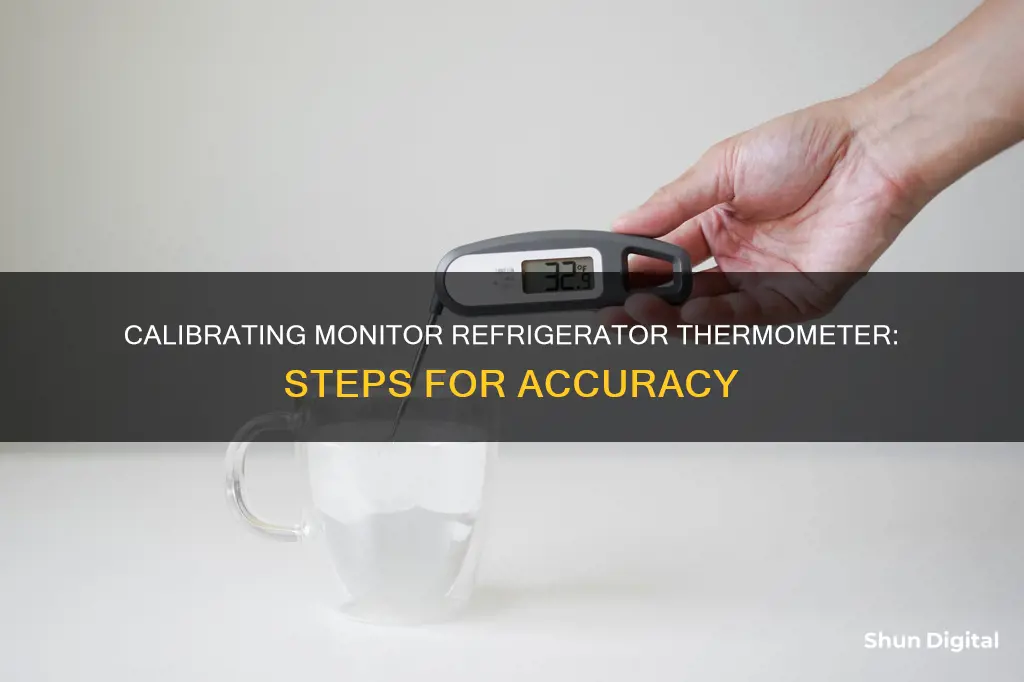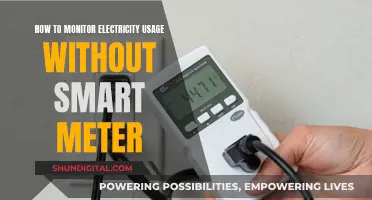
Calibration is essential to ensure that a refrigerator thermometer provides accurate temperature readings. This is important because it helps to maintain the ideal temperature for food storage, which is generally between 35°F and 40°F (1.6°C to 4.4°C) in a refrigerator and below 0°F (-17.8°C) in a freezer. If the temperature is higher than 40°F, food will spoil, and if it's lower than 30°F, food may burn from freezing. There are two common methods for calibrating a refrigerator thermometer: the boiling point method and the freezing point method. The boiling point method is suitable for elevations of 1000 feet or less above sea level, while the freezing point method can be used regardless of elevation. Both methods involve testing the thermometer's accuracy in a substance with a known temperature and then adjusting the thermometer to match that temperature.
| Characteristics | Values |
|---|---|
| Purpose of a refrigerator thermometer | To check the temperature inside the fridge and ensure it is ideal for food storage |
| Ideal temperature for cooling food | 37°Fahrenheit |
| Safe temperature range for a refrigerator | 35°F to 40°F (1.6°C to 4.4°C) |
| Safe temperature range for a freezer | Below 0°F (-17.8°C) |
| Calibration methods | Boiling point method and freezing point method |
| Boiling point method suitability | Elevations of 1000 feet or less above sea level |
| Freezing point method suitability | Any elevation |
| Boiling point method steps | Place the thermometer probe/stem in boiling water for 30 seconds or until the indicator stops moving; the reading should be 100°Celsius or 212°Fahrenheit |
| Freezing point method steps | Fill a container with crushed ice and a little tap water, place the thermometer probe/stem in the container for 30 seconds or until the indicator stops moving; the reading should be 0°Celsius or 32°Fahrenheit |
| Calibration for non-digital thermometers | Turn the adjuster nut until the correct temperature is reached |
| Calibration for digital thermometers | Press the reset button |
| Recommended recalibration schedule | Every two years |
What You'll Learn

Boiling point method
Calibration is important to ensure your refrigerator thermometer is giving an accurate reading. If the temperature is off, even by a few degrees, food can spoil or burn from freezing.
The boiling point method is ideal for elevations of 1000 feet or less above sea level. It is mainly used by food handlers who work with extremely hot food, such as candy making, but it is a useful technique to know for any type of food handling.
- Bring a pot of water to a rolling boil. The pot should be big enough to cover the tip of the thermometer.
- Insert the thermometer so that the entire sensing area is submerged. This is usually indicated by a dimple or groove on the stem. Do not let the thermometer touch the pot, as this will give an inaccurate reading.
- Wait for the thermometer to stabilise and for the temperature reading to stop changing.
- Find out the boiling point of water in your area, as this varies by elevation. For example, water boils at 212°F (100°C) at sea level, but at 5000 feet (1.5 km) above sea level, it will be 202°F (94°C). Adjust your thermometer to the correct boiling point.
- If the temperature reading does not match the boiling point, adjust it while the thermometer is still in the water.
This procedure can be dangerous, so take care not to burn yourself. The Food Safety and Inspection Service recommends clipping the thermometer into the stem sheath and lowering it into the water horizontally.
Setting Up the Multisync LCD1765 Monitor: A Step-by-Step Guide
You may want to see also

Freezing point method
The freezing point method, also known as the ice point method, is the easiest way to calibrate a refrigerator thermometer. It is ideal for those who use their thermometer to take the temperature of cold foods.
To use the freezing point method, start by filling a glass with ice water. Let the water sit for a couple of minutes so the temperature settles at 32°F (0°C). Then, immerse the thermometer probe or stem in the water, ensuring it does not touch the glass. Wait for the temperature reading to stabilise and keep the thermometer in the glass as you adjust it.
The thermometer should be accurate within 2°F (1°C). If you notice a bigger gap, you will need to adjust the thermometer. To do this, find the adjuster nut and turn it until it reaches the correct temperature. If using the freezing point method, the temperature should be 32°F (0°C). If your thermometer is digital, simply push the reset button, and this will automatically calibrate the device.
It is important to note that the freezing point method can be used at any elevation, whereas the boiling point method is best used at elevations of 1000 feet or less above sea level. It is recommended to try both methods for comparison.
The Insight: Blind Spot Monitoring Available?
You may want to see also

Adjusting the calibration nut
Locate the Calibration Nut: Before you begin, you need to find the calibration nut on your thermometer. It is usually found beneath the display dial of the thermometer. For digital thermometers, there is typically a reset button instead of a nut.
Prepare the Calibration Methods: There are two common methods for calibrating a refrigerator thermometer: the boiling point method and the freezing point method. The boiling point method involves testing the thermometer in boiling water, while the freezing point method uses ice water. Prepare the calibration method you plan to use by bringing a pot of water to a boil or creating a mixture of ice water.
Test the Thermometer's Accuracy: Before making any adjustments, you must test the accuracy of your thermometer. If using the boiling point method, place the thermometer probe or stem into the boiling water and wait for at least 30 seconds or until the indicator stops moving. The reading on the thermometer should be 100 degrees Celsius or 212 degrees Fahrenheit. For the freezing point method, immerse the thermometer probe into the ice water and wait for stabilization. The temperature should be at 0 degrees Celsius or 32 degrees Fahrenheit.
Adjust the Calibration Nut: If the thermometer reading does not match the expected temperature, you will need to adjust the calibration nut. Hold the nut with a wrench or pliers and gently turn it until the thermometer displays the correct temperature. Be careful not to apply too much force, as it may damage the thermometer.
Recalibrate and Test Again: After adjusting the calibration nut, recalibrate your thermometer by repeating the chosen calibration method. Test the thermometer's accuracy again to ensure it provides the correct temperature readings. If the thermometer is still inaccurate, you may need to repeat the adjustment process or consider replacing the thermometer if it cannot be calibrated further.
By following these steps for adjusting the calibration nut, you can ensure that your refrigerator thermometer is properly calibrated and provides accurate temperature readings. This is essential for maintaining the ideal temperature in your refrigerator to keep your food fresh and safe to consume.
Monitoring Kids' Social Media: Parenting in the Digital Age
You may want to see also

Resetting a digital thermometer
Firstly, you need to know when to calibrate your thermometer. You should calibrate it before using it for the first time, after dropping it, and when measuring extreme temperatures. Regular calibration (daily or weekly) is also necessary if you use your thermometer frequently.
To reset your digital thermometer, you can use either the freezing point method or the boiling point method. For the freezing point method, fill a glass with crushed ice, add a little water, and stir. After a few minutes, place the thermometer's probe into the centre of the glass, ensuring it doesn't touch the ice. Wait 30 seconds and check the reading. If it doesn't read 32°F or 0°C, you will need to calibrate it.
The boiling point method is similar. Boil a pot of water and place the thermometer probe into the centre of the pot, again waiting 30 seconds. If the thermometer doesn't read 212°F or 100°C, it needs to be calibrated.
To calibrate a digital thermometer, you can usually simply locate and press the reset button until the correct temperature is displayed. Some thermometers may require you to adjust a nut or potentiometer.
It's important to remember that a single-point test only ensures accuracy at one temperature, so it's best to perform both tests for the most accurate calibration.
Identifying Your Monitor: 16:9 Aspect Ratio Detection
You may want to see also

Re-calibration and maintenance
To ensure your refrigerator thermometer is functioning correctly, it is important to calibrate it regularly. The calibration schedule depends on the type of thermometer you use. For instance, bimetal thermometers should be calibrated before every shift, while digital thermometers should be calibrated every week or month. Always calibrate a new thermometer or one that has been dropped. It is also a good idea to calibrate after using it to measure significantly different temperatures.
To recalibrate your refrigerator thermometer, start by determining whether to use the boiling point method or the freezing point method. The boiling point method is ideal for elevations of 1000 feet or less above sea level, while the freezing point method can be used regardless of elevation. For the most accurate results, it is recommended to try both methods and compare the readings.
If using the boiling point method, place the thermometer probe or stem into a container of boiling water and wait for at least 30 seconds or until the indicator on the thermometer stops moving. The reading on the thermometer should be 100°C or 212°F.
For the freezing point method, fill a container with ice water and add a little tap water. Place the thermometer probe or stem into the container and wait until the indicator stops moving or for at least 30 seconds. The temperature should read 0°C or 32°F.
If the thermometer reading does not match the expected temperature, you will need to adjust it. For digital thermometers, this can usually be done by pressing a push button. For other types of thermometers, such as bimetal thermometers, you may need to use a wrench or pliers to turn an adjustment nut.
In addition to regular calibration, there are a few other things to keep in mind to maintain your refrigerator thermometer:
- Place the thermometer in the correct location within the refrigerator. It is recommended to take measurements just below the top shelf, in the middle, or closer to the door.
- Adjust the refrigerator temperature as needed based on the thermometer readings. You may need to make a few adjustments to find the ideal setting.
- Readjust the temperature settings between the warmer and cooler months, as the external temperature can impact the refrigerator's performance.
- Keep the thermometer clean and free of debris.
- Regularly check the battery or power source of the thermometer to ensure it is functioning correctly.
- Store the thermometer in a safe place when not in use to avoid damage.
ATT Monitoring Hotspot Usage: What You Need to Know
You may want to see also
Frequently asked questions
There are two methods to calibrate a refrigerator thermometer: the boiling point method and the freezing point method. For the boiling point method, place the thermometer probe into a container of boiling water for 30 seconds or until the indicator stops moving. The reading should be 100°C or 212°F. For the freezing point method, fill a container with crushed ice and a little water, then place the thermometer probe into the container for at least 30 seconds. The reading should be 0°C or 32°F. If the thermometer is not digital, you will need to turn the adjuster nut until the correct temperature is reached. If it is digital, simply push the reset button.
To ensure accurate temperature readings, a refrigerator thermometer should be re-calibrated every two years.
The ideal temperature for cooling food inside a refrigerator is 37°F. Any higher than 40°F and food will spoil, and if it's lower than 30°F, food may burn from freezing.
Calibration ensures that temperature monitoring equipment maintains the highest level of accuracy. Over time, even calibrated devices will experience drift and display inaccurate temperature readings.
Thermometers should be calibrated before use, if they are dropped, when going from one temperature range to another, and after extended storage time.







